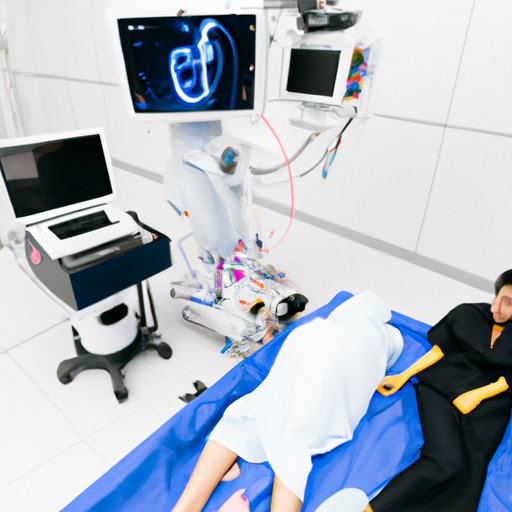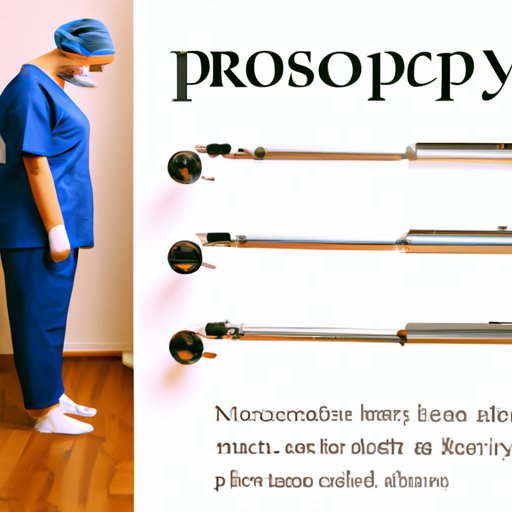Introduction
A robotic hysterectomy is a surgical procedure in which a doctor uses a robotic device to remove the uterus or other parts of the reproductive system. This minimally invasive technique is designed to reduce the risk of complications and make recovery times faster than traditional methods. But just how long does a robotic hysterectomy take?

Comparing the Duration of Robotic Hysterectomy to Traditional Methods
When considering the duration of a robotic hysterectomy, it is important to compare it to traditional methods. The pre-operative preparation for each procedure is similar; patients typically need to fast for 8-12 hours before the procedure and must follow instructions from their doctor regarding medications, supplements, and any other preparations needed.
The actual duration of the robotic hysterectomy depends on the complexity of the case and the type of surgery being performed. On average, a robotic hysterectomy takes between 1-2 hours, while a traditional hysterectomy can take up to 3 hours.
In terms of post-operative recovery, robotic hysterectomy patients typically experience less pain and discomfort than those who undergo a traditional hysterectomy. Additionally, patients undergoing robotic hysterectomy often have shorter hospital stays, with some patients going home the same day as the procedure.
Evaluating the Effectiveness of Robotic Hysterectomy in Reducing Recovery Time
Robotic technology has revolutionized the field of gynecology by streamlining the hysterectomy process. The precision of the robotic arms allows surgeons to operate with greater accuracy, reducing the risk of complications and allowing for shorter recovery times. Studies have shown that robotic hysterectomies are associated with reduced levels of pain, shorter hospital stays, and faster healing times than traditional methods.
Robotic technology also makes it easier for surgeons to perform complex surgeries, such as removing large tumors or fibroids. This reduces the amount of time spent in surgery, further decreasing recovery time. In addition, robotic hysterectomies are less likely to cause damage to surrounding organs, which can lead to longer recovery times.

Investigating How Long Robotic Hysterectomy Takes Depending on Patient Health Conditions
Patient health conditions can also play a role in determining the duration of a robotic hysterectomy. If a patient has an existing medical condition, such as obesity or diabetes, this can increase the amount of time needed for the procedure. Additionally, if a patient has a large tumor or fibroid, this can extend the duration of the robotic hysterectomy.
Other factors, such as the size of the uterus or the complexity of the procedure, can also influence the length of the surgery. For example, if the surgeon needs to remove a large tumor or multiple fibroids, this will require additional time. Additionally, if a patient requires a more complex procedure, such as a radical hysterectomy, this can add to the duration of the robotic hysterectomy.

Evaluating the Pros and Cons of Robotic Hysterectomy Based on Length of Procedure
The shorter duration of robotic hysterectomy can be advantageous for both the patient and the surgeon. Shorter surgery times mean less risk of complications, faster recovery times, and fewer days spent in the hospital. Additionally, shorter surgery times can allow for more efficient use of resources, such as operating rooms and staff.
However, there are potential drawbacks to shorter surgery times. A shorter procedure means that the surgeon may not have enough time to complete the surgery correctly. Additionally, a shorter procedure may mean that the surgeon does not have enough time to adequately address any complications that may arise during the surgery. As such, it is important for patients to discuss the risks and benefits of shorter surgery times with their doctor before proceeding with a robotic hysterectomy.
Conclusion
Robotic hysterectomy is a minimally invasive surgical procedure that can reduce the duration of the procedure compared to traditional methods. On average, a robotic hysterectomy takes between 1-2 hours, while a traditional hysterectomy can take up to 3 hours. Additionally, robotic technology can help streamline the procedure, reducing the risk of complications and allowing for faster recovery times. However, certain health conditions can increase the duration of a robotic hysterectomy, so it is important for patients to discuss the risks and benefits of the procedure with their doctor before proceeding.
Overall, robotic hysterectomy has the potential to reduce recovery times and improve the quality of life for patients. With the right preparation and discussion with one’s doctor, a robotic hysterectomy can be a safe and effective option for many women.
(Note: Is this article not meeting your expectations? Do you have knowledge or insights to share? Unlock new opportunities and expand your reach by joining our authors team. Click Registration to join us and share your expertise with our readers.)
